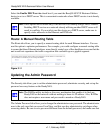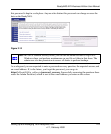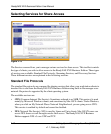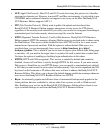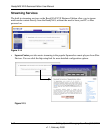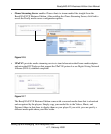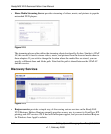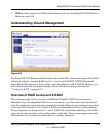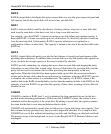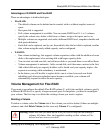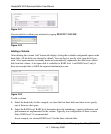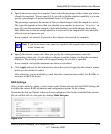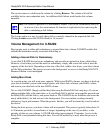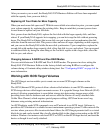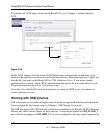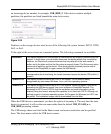
ReadyNAS NVX Business Edition User Manual
2-16 Setting Up and Managing Your ReadyNAS NVX
v1.1, February 2009
RAID 0
RAID 0 (striped disks) distributes data across several disks in a way that gives improved speed and
full capacity, but all data on all disks will be lost if any one disk fails
RAID 1
RAID 1 (mirrored disks) could be described as a backup solution, using two or more disks that
each store the same data so that data is not lost as long as one disk survives.
For example, a two-disk RAID 1 volume can sustain a one-disk failure and continue running. A
three-disk RAID 1 volume can sustain up to two disk failures. If a disk fails, the data is retrieved
from the surviving disk. Unfortunately, RAID 1 capacity utilization is not optimal in a
configuration of three or more disks. The capacity is limited to the size of the smallest disk in the
RAID set.
RAID 5
RAID 5 (striped disks with parity) provides the best balance of capacity and performance while
providing data redundancy. It combines three or more disks in a way that protects data against loss
of any one disk; the storage capacity of the array is reduced by one disk.
RAID 5 provides redundancy by striping data across three or more disks and keeping the parity
information on one of the disks in each stripe. In case of disk failure, the surviving disks and the
parity disk are used to reconstruct the lost data, providing data transparently to the user
application. When the failed disk has been replaced with a good disk, the reconstructed data is
written out to the new disk; when the reconstruction (or sometimes referred as RESYNC) process
is complete, the volume returns to a redundant state. The capacity of a RAID 5 volume is the
smallest disk in the RAID set multiplied by one less than the number of disks in the RAID set. For
example, a four-disk RAID 5 set provides the capacity of three disks, assuming all four disks are
identical in size.
X-RAID2
X-RAID2 is similar to RAID level 5, as it is optimized for large sequential access for the best
possible media streaming performance. With a one-disk X-RAID2 volume, the volume is non-
redundant and has the capacity of the single disk. By adding a second disk, the capacity remains
the same, but the data is now mirrored between the two disks.
X-RAID2 will automatically expand when as little as two of your disks have extra capacity. Your
data volume can keep growing every time you add a larger disk after that. It’s as simple as that.
X-RAID2 lets you do this without reformatting your disks and shuffling your data back and forth.
The process occurs in the background, so access to the ReadyNAS NVX Business Edition is not
interrupted.



